



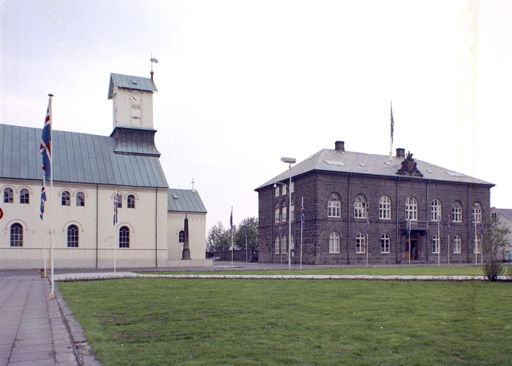
|
| Cathedral and Parliament, Reykjavík |
|
This is one of the few interesting pictures I took when I was in Iceland in June 1969. More comment below. There is a big version as well as a small. |
A full and busy day today, with arrival, meeting all but two of the other walkers, and getting a feel for Reykjavík.
I had traveled to Iceland before, in June of 1969. You can read more of the circumstances of this trip in the Appendix.
I had my somewhat trusty Bronica-S with me, and took a lot of pictures, both BW and color negatives, and on my return this year, I dragged the negs out to see which ones might be interesting. Very few, it turns out! I was sure that I had taken all sorts of in-town scenes of Reykjavík, but almost all of these were of the harbor, and none show the treelessness that I recalled, in comparison to the wonderful planting that I saw there in 2010.
(*) Icelanders don’t ordinarily have family names: the second name is usually a patronymic: you’re So-and-so’s son or Somebody’s daughter. And I never caught Hulda’s patronymic. If I read Arnaldur Indriðason’s books correctly, the patronymic is not used in everyday dealings with people, contrary to the way it is among Russians.
As soon as Mark and I got through Customs at Keflavík airport, we saw one of our guides, Kristín Björnsdóttir, waiting for us with a big sign saying “Country Walkers”. The other walkers on our plane showed up soon after, and we were on our way to The Blue Lagoon in a bus driven by Hulda(*), whose excellent services we had for the whole tour.
We unfortunately took no pictures at the Lagoon: I wouldn’t take my camera near water, and it seems that Mark just forgot to take his water-proof one to the spa. It’s a very interesting place, and was an excellent choice for getting us to unwind after our flights. We met four more of the walkers there, Jerye Motschman, Gisele Cole, and Ronnie Dillon and her husband Kevin Bollbach. They had been brought there by our other guide, Erling Aspelund. He and Kristín are a married couple, partners in Iceland Encounter, their adventure travel company. The two are loads of fun, good company, and of course filled with information about Iceland.
All of the walkers but the avid photographer Gisele soaked in the warm opaque-blue water, effluent from a geothermal plant. It flows out of the plant after having given up most of its heat, but none of the mineral content it had in the bowels of the earth. Gisele should have loads of pictures of the rest of us, or at least of our heads, poking out of the blue milk.
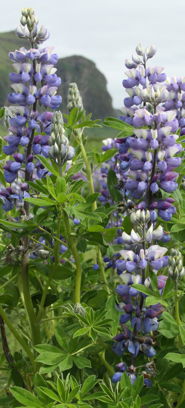
The Blue Lagoon is on the Reykjanes peninsula, a geologically very young part of Iceland, where there is little topsoil and little vegetation, except for the Nootka Lupine (Lupinus nootkatensis) that seemed to me to be one of the new features in the Icelandic landscape. It may well be that I just wasn’t looking in 1969, or that my memory has simply failed me—this is getting more and more to be the case these days. But I don’t recall the extensive fields of lupine from my previous visit. The plant, an Alaska native, was introduced in 1945, my sources on the web say, and has proved to be extremely invasive. Maybe this is good: as a legume, the plant has certainly enriched the soil it grows in; and it seems to have served well to hold down sandy soil from being blown away by the wind. On the other hand, it is tall, and shades out many of the native species; furthermore, the dead stalks from previous years make something of a mat on the ground that must surely discourage smaller plants. I don’t find the fairly heavy purple color attractive at all; but we saw patches of a nice creamy white among the lupine in some places, and thought that these were a color variant of the plant, rather than another species poking up. Without getting up close, though, we couldn’t be sure.
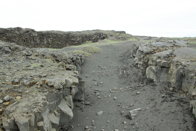
The Mid-Atlantic Ridge, where the North American and Eurasian plates are pulling apart from each other, runs right through Iceland, and perhaps as a nice introduction to Icelandic geology, Kristín had Hulda stop the bus at place where the rift is visible as a relatively shallow gash in the landscape, as you see on the left (big image, small). We would see a much more dramatic view of the Rift the next day.
Next stop was Hótel Centrum in Reyjkavík, where we put our bags up in our room and immediately went for lunch at a nice busy restaurant where we had Icelandic beer and a meal that was billed as an Icelandic tasting menu: fish stew served in little Mason jars, smoked lamb and smoked trout. Very pleasant, though I found the fish stew a bit bland till I loaded it with pepper.
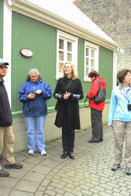
Then we went walking through the city. My recollection of Reyjkjavík in 1969 is that it was very bare, with at most a few trees. I remarked to Kristín as Hulda was driving us through the outlying parts of the city towards the center that the area now seemed much more heavily planted with trees. They all are only moderate-sized, easily younger than forty-one years, but the possibility must be allowed that my memory has served me ill. Unfortunately, none of my pictures from the previous visit are from the same viewpoint as those I took in town this time. In the picture to the right (big image, small), Kristín is explaining some of the local history to Paul, Jerye, Gisele and Margie. We went all over the central part of town, and Kristín pointed out various restaurants we might eat at when we were on our own: remember that we were still on the pre-tour supplementary walk, and it would be up to us to choose a place to eat at come evening.
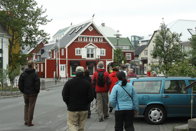
Five minutes later, we were in a flatter part of town, and in the picture to the left you see everybody’s back (I’m always at the rear, fussing with my camera). Notice the bright colors, and the trees; note also the prevalence of skylights on roofs. (Big image, small.)
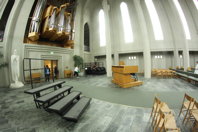
In a perfectly calm pool, a fish looking up will see a 180° view of the airy world, considerably distorted, but compressed into a circle of much smaller angular diameter than 180°. A fish-eye lens, thanks to the wizardry of the lens-designers, does the same thing: there should be just about a 180° view from corner to corner. The cost is that all straight lines come out curved, except those that pass through the optical center. The result is an extreme barrel distortion.
We made our way to the most imposing building in the city, Hallgrímskirkja (Hallgrím’s Church), honoring the seventeenth-century poet and pastor Hallgrímur Pétursson. It’s grand both inside and out, and I decided to make use of my fish-eye lens.
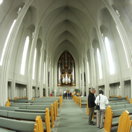
|
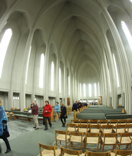
|
In the picture to the right, you see the east end of the church, with its organ case (big image, small), and at the left, the upper shot is a view straight down the central aisle, but now with the organ case in the distance and Diane and John in the foreground (big image, small), while the lower shot looks toward the nave (big image, small). Maroon, red, and blue jackets are Mark, Gisele, and Margie.
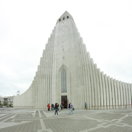
Hallgrímskirkja is made of concrete: there’s no native stone in Iceland appropriate for building out of. This accounts for the smoothness of the interior, and perhaps the monumentality of the exterior as well. That’s it to the right (big image, small). We are told that the inspiration for the patterning of the exterior is the columnar basalt that we saw so much of later on in our tour; I also was reminded of an organ case, and Grundtvig’s Church in Copenhagen. Perhaps what I liked most about the church was that there is no stained glass. That may have its place, I suppose, as in the Sainte-Chapelle in Paris, but I don’t think it belongs in a Protestant church. There’s good reason for not obscuring the windows in Hallgrím’s Church, though: you want as much light as possible when the sun is mostly very low above the horizon, and there’s lots of cloud cover too.
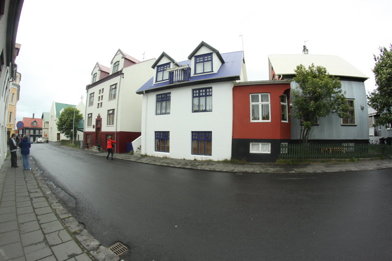
|
|
One last fish-eye picture. This Reykjavík street is really perfectly straight. It’s a nice town to walk in, no doubt about that. (Big image, small.) |
That was our walk for the day, and the end of the supplement. One of the restaurants that Kristín pointed out to us was Fiskfélagið (The Fish Company), and we weren’t the only ones from the Country Walkers tour who tried it out this night. It was very elegant, and rather expensive. (Of course everything in Iceland is expensive, but that’s another issue!) I chose scallops and shrimp for a starter, while Mark had porkbelly with gnocchi. For the main courses, mine was Char decorated with three presentations of apple, plus Jerusalem artichokes, while Mark’s was Salmon with similarly three forms of corn. My three were stewed apple, apple chips, and apple foam, very precious, as Mark has complained on; his three were kernel corn, polenta, and popcorn. My meal was fine, but not really to my taste. The starter included a “slow-cooked” egg, which might as well have been raw, and which I found to be a subtraction from rather than addition to the dish’s totality. The Char was fine, but I would rate the whole meal more imaginative than delicious. We certainly had better meals in dinky towns along the coast later on—I won’t link to them, but make you wade through the wordiness before you find my comments on them. We finished the meal with coffee, but no dessert, ’cause we were rather too full for that. And then to bed.
Next day’s pictures, previous day’s pictures. Return to the central Iceland page; to the central travel page; to my home page.